Loch Venachar Fish Pass (2020)
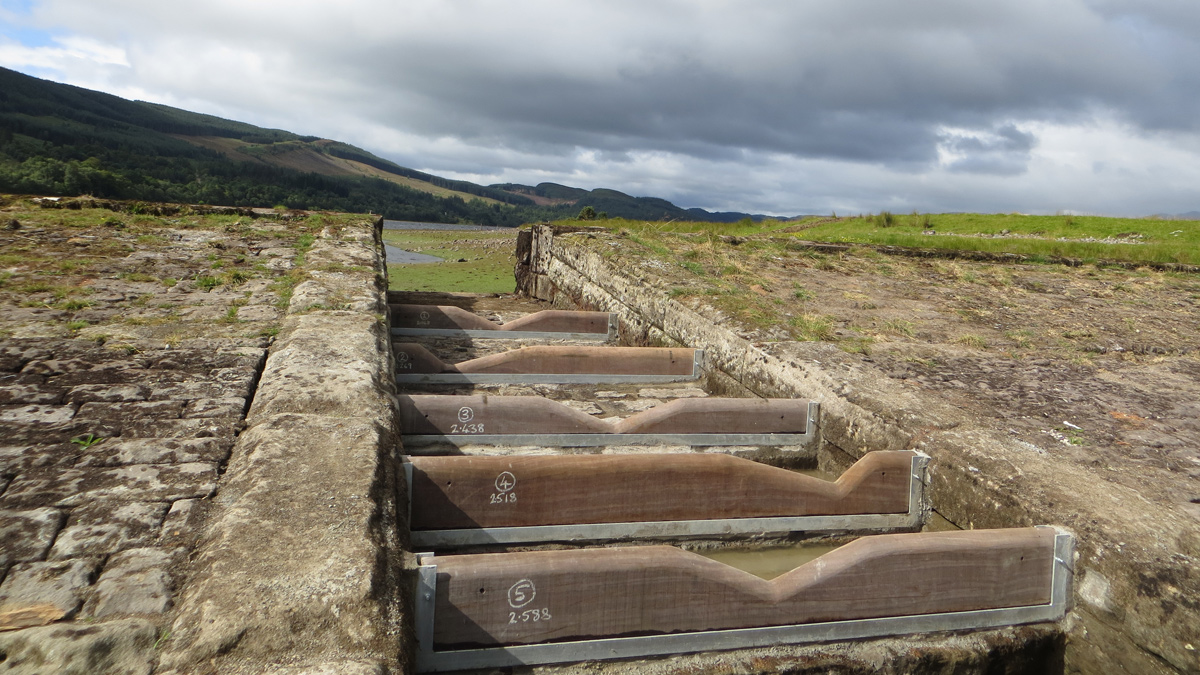
Completed fish pass, looking upstream - Courtesy of the Loch Venachar project team
Loch Venachar Reservoir is located near Callander in Loch Lomond and the Trossachs National Park. The reservoir was formed in 1859 under the direction of civil engineer John Frederick Bateman (1810-1889), when the existing loch level was raised by the construction of a masonry dam across the outlet from the loch known as the Eas Gobhain. It was built as part of the Loch Katrine Water Scheme, which remains the principal source of supply to the City of Glasgow, to prevent abstractions from Loch Katrine adversely impacting downstream river flows by providing compensation waters to the River Teith (a tributary of the River Forth). The Glasgow Water Works Corporation Scheme built the dams at Katrine and Venachar and was one of the most ambitious civil engineering projects undertaken in Europe since antiquity. The scheme was carried out to provide a clean drinking water supply to Glasgow, which had suffered from cholera outbreaks, and hydraulic motive power to its developing heavy industry. The unique importance of the scheme to architectural and engineering heritage has resulted in the Loch Venachar Dam being classed as a Category A structure by Historic Scotland.
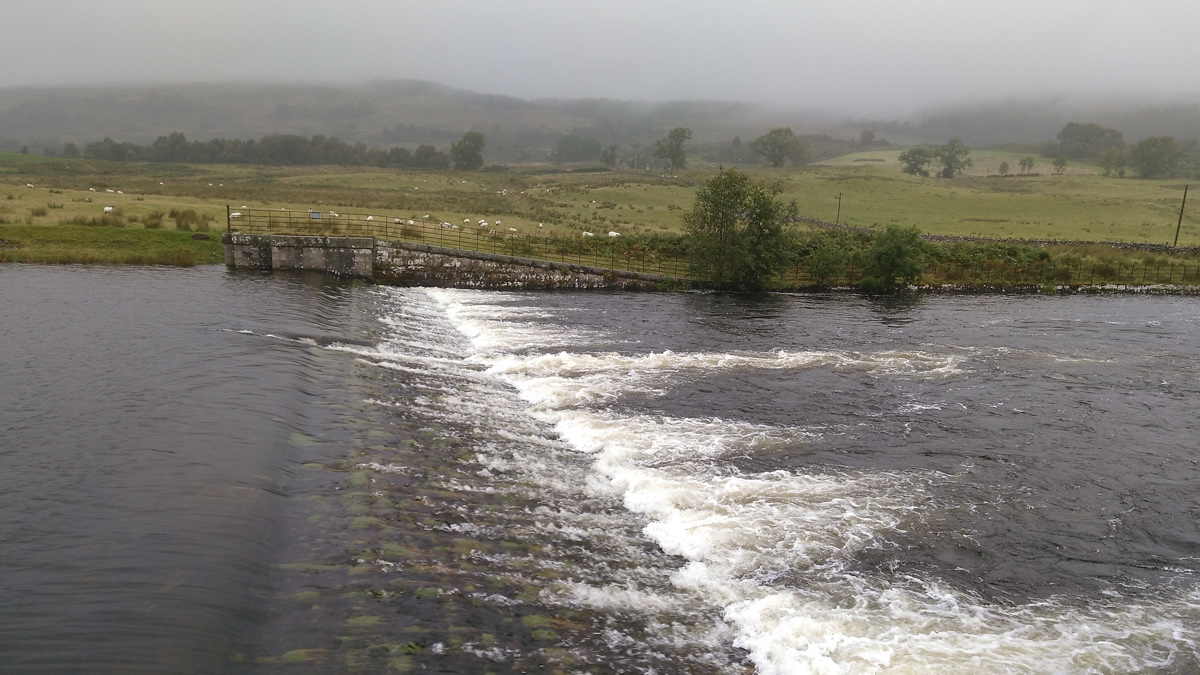
Overflow weir in spill, September 2019 – Courtesy of the Loch Venachar project team
Background
The dam is formed of a masonry/concrete sluice house with 11 arched sluice openings at varying levels for discharging water into the sluice house channel, and a masonry overflow weir which discharges water into the overflow weir channel. These parallel channels then combine approximately 600m downstream of the dam. Existing provision of fish passage is provided by:
- Sluice house channel: A pool and traverse type fish pass, fed by three of the upper sluices, this structure is one of the earliest examples of a Victorian fish pass.
- Overflow weir channel: A low-flow notch in the weir, approximately 1m deep and 2m wide, known as the ‘salmon slap’. This appeared to have been modified from its original state, with the installation of layers of masonry blocks on top of the original low-flow channel invert to make the channel shallower.
The passability of the low flow channel was found to be unsatisfactory in the 2012 Optioneering Report. During high loch levels the dam regularly spills through the overflow channel. Spill flows over an impassable barrier lead to a risk of fish being attracted to the northern channel, and the base of the weir, but unable to access the loch over the dam. On this basis Scottish Water undertook to carry out a project to improve the passability of the structure weir. The report set out a number of potential options for improving fish passage in the overflow weir. In collaboration with SEPA, Scottish Water selected to provide a fish passage ‘easement’ to the channel with timber baffles to break up the flow velocities in the channel and provide conditions more suitable for traversal by migratory salmonids. Timber baffles represented a practical easement solution in keeping with the characteristics of the dam.
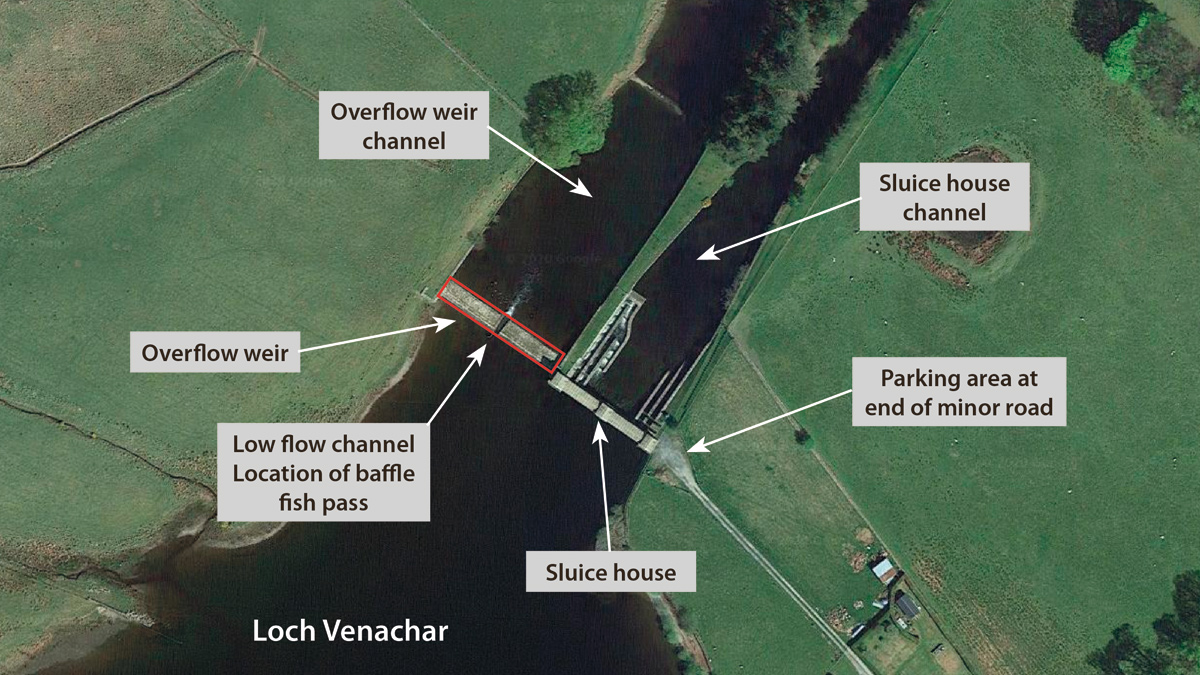
Google Maps plan of site – Courtesy of the Loch Venachar project team
Design
In 2019 Scottish Water asked Mott MacDonald to undertake detailed design of the preferred option from the 2012 Optioneering Report, of installation of baffles within the overflow weir low-flow channel, to improve fish passage for salmonids. The first step in the design process was to undertake a site visit to understand the design requirements. This was attended by various Scottish Water staff including operations, planning and environmental specialists, representatives from the Forth Rivers Trust, and the Mott MacDonald design team including a fisheries specialist sub-consultant. The detailed design was then undertaken following a discussion of key site findings and agreeing design parameters with Scottish Water, the fisheries specialist sub-consultant and SEPA.
The project was managed by Scottish Water’s Managed Delivery team. Securing planning and listed building consent, alongside stakeholder management, environmental assessments and permission for working in a watercourse were managed by Scottish Water Specialist Services Delivery department.
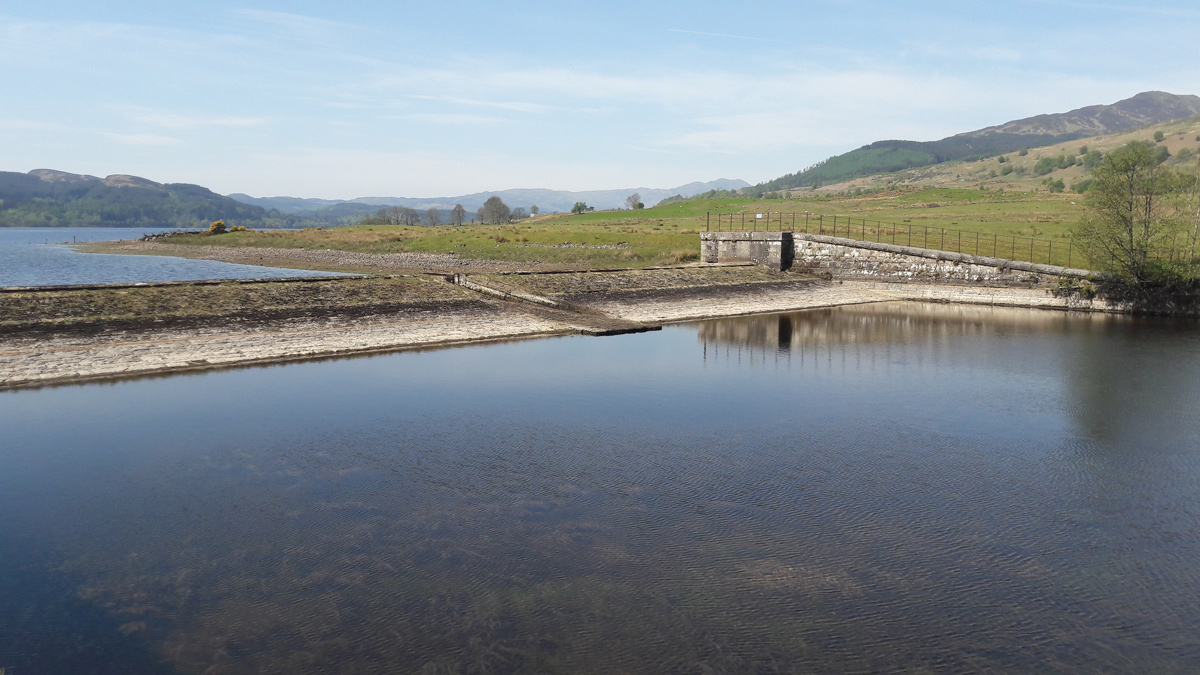
Overflow weir dry, May 2019 – Courtesy of the Loch Venachar project team
The detailed design comprised 5 (No.) baffles of varying profiles, which are to slot into guides made of parallel flanged channels (PFCs), fixed to the sides and base of the low flow channel. The key requirements and constraints on the design were as follows:
- The channel is to be modified with the installation of baffles, with minimal visual impact to the existing structure as the dam structure is an historic monument, and the materials used were to be timber and masonry to be sympathetic to the early Victorian aesthetic of the dam.
- The baffles are to have a variable profile to accommodate a wider range of water flow/depth i.e. each baffle is to incorporate a v-notch.
- The top water level (TWL) of the reservoir is defined by the weir level at the head of the low-flow channel, (81.34mAOD), and must remain unchanged by the design, as otherwise the works would require approval by an All Reservoir Panel Engineer (ARPE).
- Due to the reduction in channel wall height with length, the downstream end of the channel is to be deepened by removal of the existing invert, which was believed to consist of masonry blocks overlaying the original masonry weir. This deepening will enable flow to be kept in-channel rather than spilling over the downstream weir face. This was agreed as the preferred design, rather than the alternative of raising the existing walls, to reduce the visual impact of the works.
- The minimum reservoir water level at which the channel will be passable is 81.62mAOD (TWL + 0.15m). This will provide 0.15m depth in the channel ‘exit’ which is the minimum recommended depth criteria for notch, baffle and baulk designs.
- The maximum velocity through the channel for fish passage was to be 3m/s.
- The maximum power dissipation between the baffles when the baffles control the flow was to be 200 W/m3.
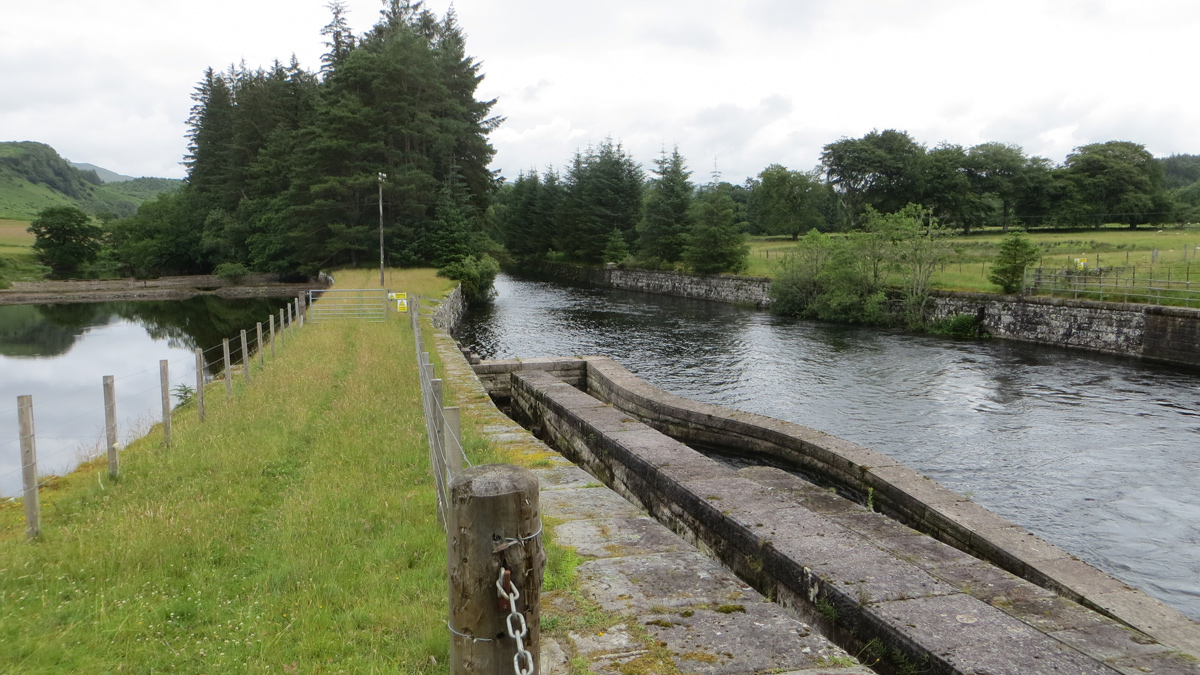
Existing Victorian era pool and traverse type fish pass – Courtesy of the Loch Venachar project team
Loch Venachar Fish Pass: Supply chain – key participants
- Client/project management: Scottish Water
- Principal designer: Mott MacDonald
- Principal contractor: George Leslie Ltd
- Steelwork fabrication and installation: Direct Engineering
- Supply and fabrication of timber baffles: Gilmour & Aitken Ltd
Construction
The scope of the construction works was as follows:
- Removal of the existing redundant remains of the wooden structure at the head of the low flow channel and associated brackets.
- Removal of masonry blocks at the downstream end of the channel to provide sufficient depth of flow for fish passage in the channel.
- Minor pointing works in the channel to stabilise the existing masonry where there has been mortar loss.
- The installation of 5 (No.) baffle guides formed of PFC channel sections, bolted to the low flow channel invert and side walls, with the gap between the channels and adjacent masonry grouted.
- The installation of 5 (No.) baffles, placed into the PFC channels. The baffles were to be of a suitable material approved by Scottish Water and SEPA, and for this, Ekki timber was chosen. The baffles were to be secured to the guide on either side using bolts, and are to have a lifting point at each end.
Construction was due to start in April 2020 following a period of dry weather so that the works could be undertaken when the reservoir was not spilling. However, this was delayed until June 2020 due to restrictions in place as a result of the Covid-19 pandemic.
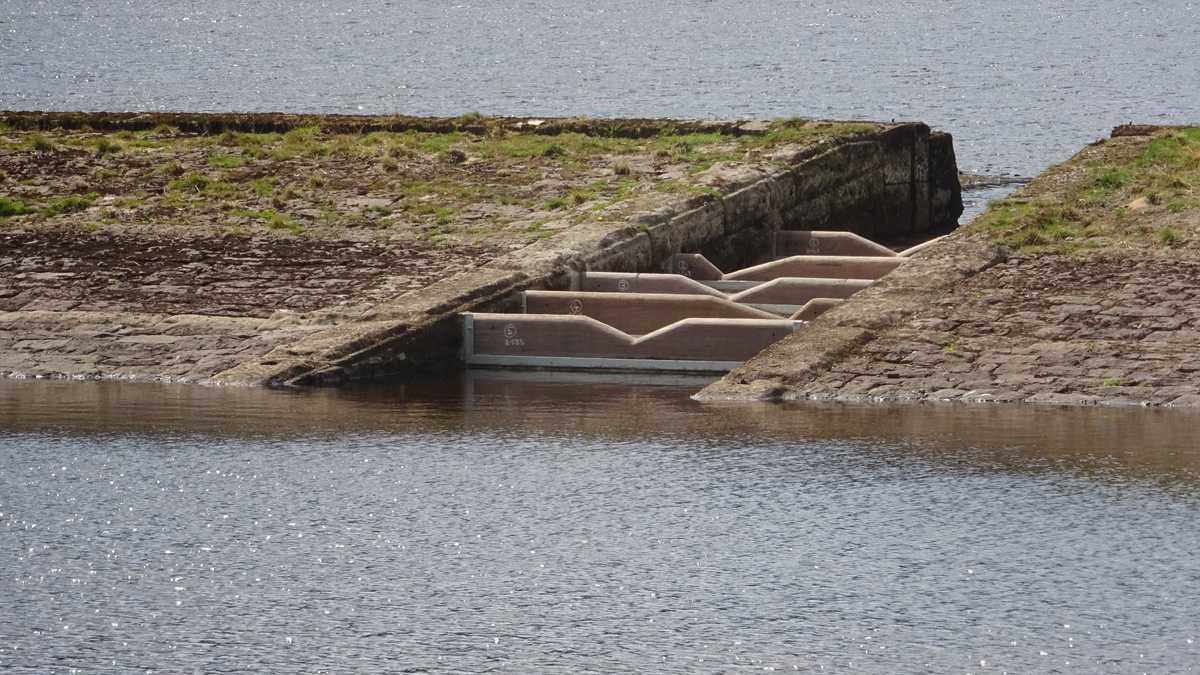
Completed fish pass, looking upstream – Courtesy of the Loch Venachar project team
Construction began on 22 June 2020 following teleconferences between Scottish Water, Mott MacDonald and the principal contractor, George Leslie Ltd, to discuss programme, methodology and how the site would be managed. After the redundant wooden structure had been removed, the first major section of work was to remove the masonry blocks at the downstream end of the channel. However, after removing the first level of blocks, a layer of gravel and larger stones was found below this. It was initially unclear if this layer of gravel extended all the way down to the original masonry invert, and so further investigation was required in the form of a trial pit. This confirmed that the side walls continued down to the original invert, which was in good condition, and that the gravel was only an infill layer to potentially save on materials and labour.
As this arrangement differed from what had been assumed at the design stage, Mott MacDonald prepared sketches of two potential options to reinstate the invert of the low-flow channel. Both options ensured that the level of the baffle inverts and the pool depths would not change from the original design:
- Option 1: Use masonry blocks removed from the downstream end of the channel to re-lay the invert at a lower level to the end of the baffle pass, with a deeper pool in front.
- Option 2: Use masonry blocks removed from the downstream end of the channel to completely re-lay the invert at a lower level along the entire channel.
Both sketches were reviewed by a Mott MacDonald engineer from a reservoir safety standpoint. Option 1 was chosen as it was preferred by George Leslie Ltd and the Scottish Water Reservoir Engineer, as it involved less manual handling of very heavy masonry blocks. The remainder of the masonry blocks (around 10 tonnes in total) were removed from site using a small excavator and grab lorry and were set aside for re-use at another Scottish Water reservoir nearby.
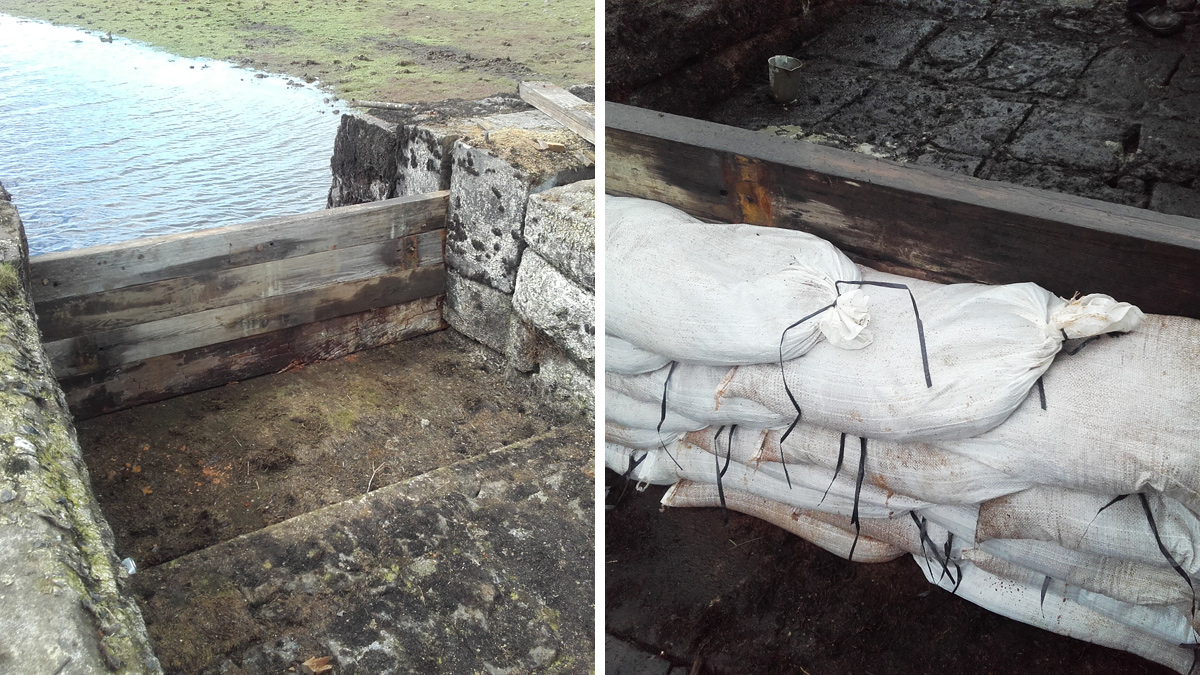
(left) Stop log arrangement to protect channel from flooding during works and (right) sandbagging arrangement to protect channel from flooding during works – Courtesy of the Loch Venachar project team
An additional challenge during construction was water level management. After a prolonged period of dry weather, the weather became unsettled around two weeks into the construction programme. This caused a slight rise in the reservoir level but was still well below the level of the low-flow channel invert. As a precaution, stop logs were formed using the redundant timber structure removed from the reservoir, and then slotted into a stop log groove at the upstream end of the channel. Rainfall also caused flow from a field drain to fill up the downstream pool which meant the water level had to be managed to complete the excavation works. This was achieved by forming rows of sandbags at the downstream end of the channel to exclude the water and then using pumps (directed into the reservoir) to remove any residual water.
After the reinstatement of the channel, the PFC baffle guides were then installed by Direct Engineering, a specialist metalwork subcontractor, who had also fabricated the guides. The guides were bolted to the masonry side walls and base of the channel. Any gaps remaining between the guides and the channel were grouted by George Leslie Ltd. After this, the baffles, pre-manufactured off-site by Gilmour & Aitken Ltd, were lifted into place by George Leslie operatives (using a two-person team and lifting eyes at either end), and then bolted into place through the guides.

Completed fish pass with Victorian era sluice house visible in background – Courtesy of the Loch Venachar project team
Conclusion
The site works were completed on 27 July 2020 within a five week period. However, it’s expected that the fish pass will not be operational until later in the year once Loch Venachar regains volume and starts spilling.



